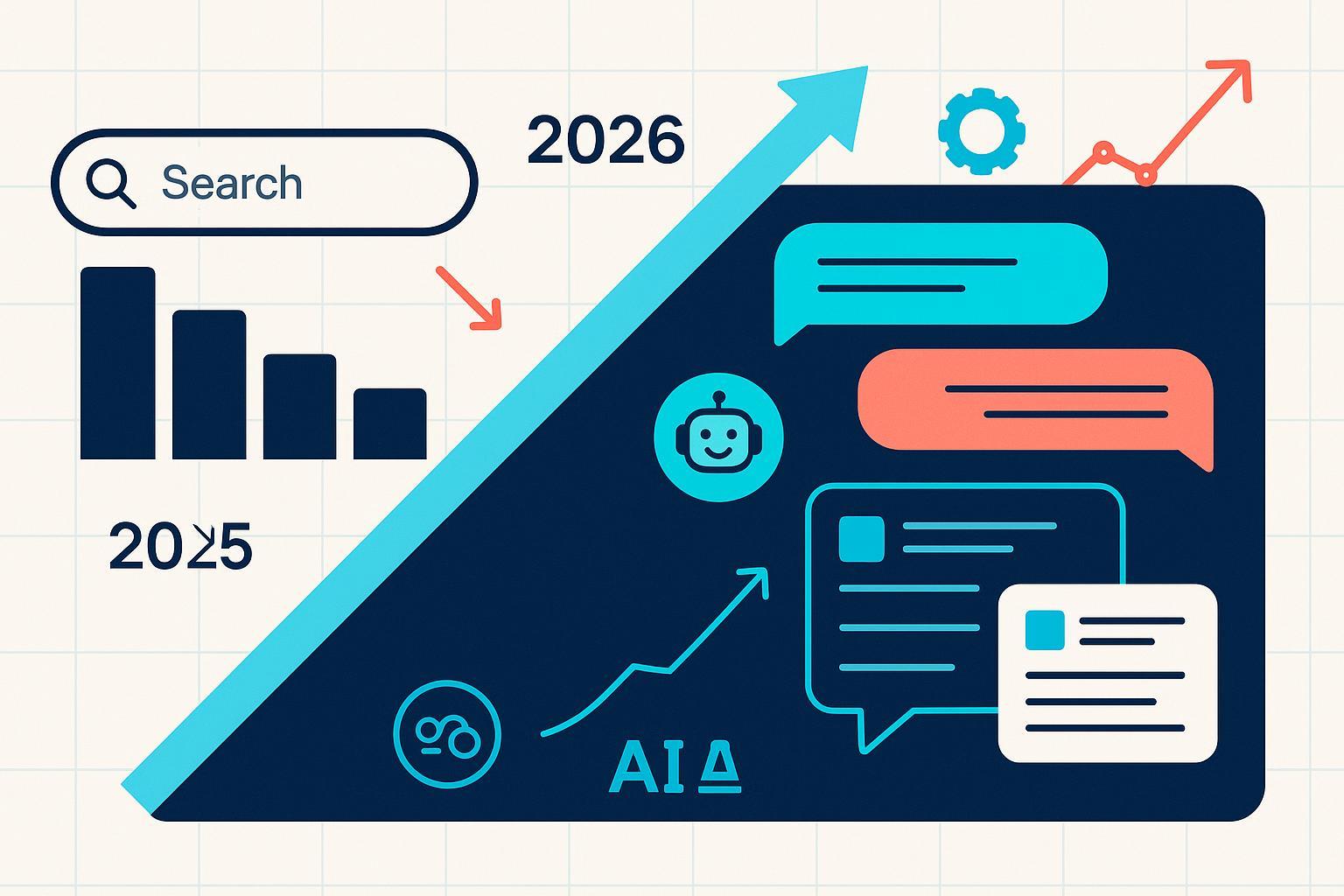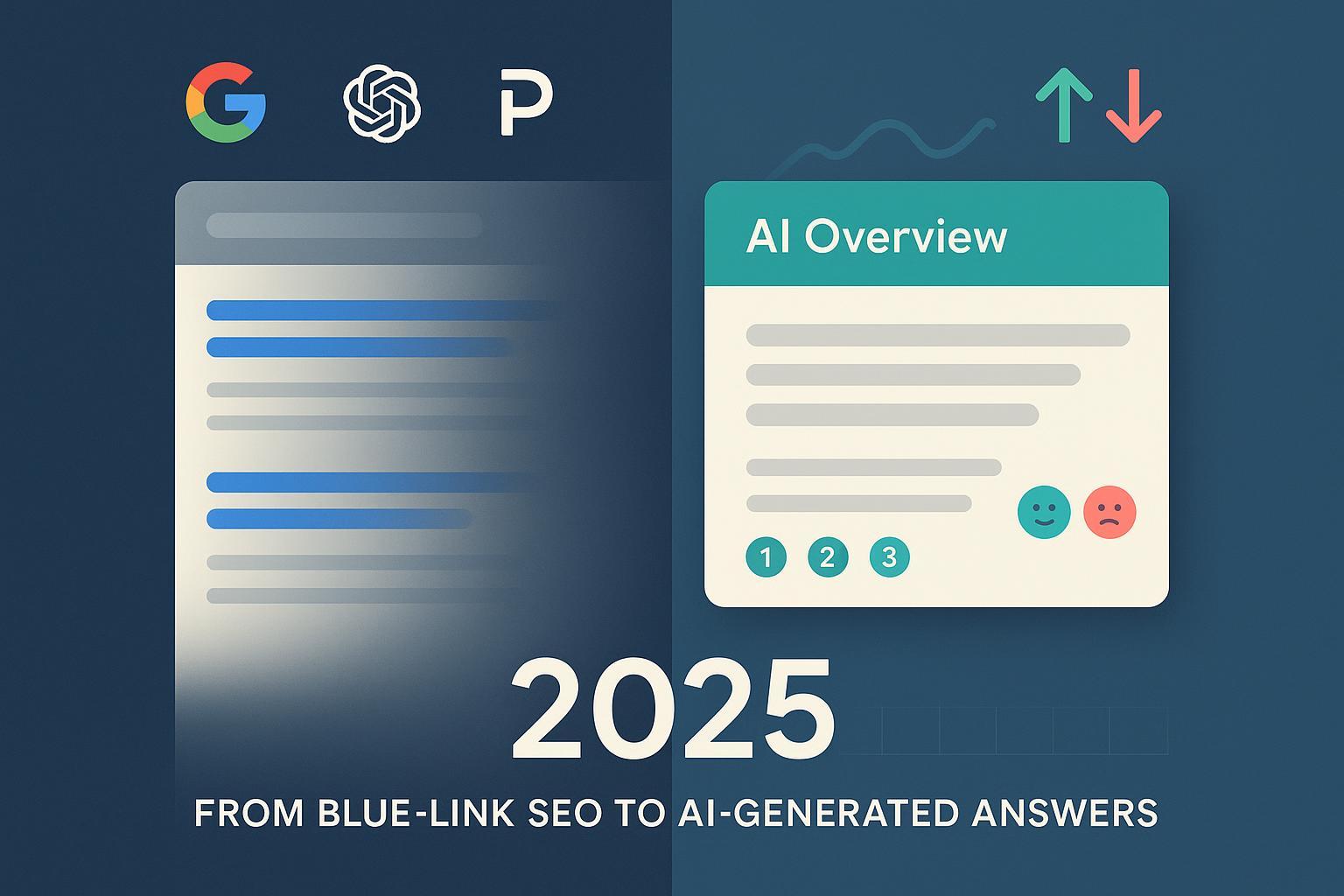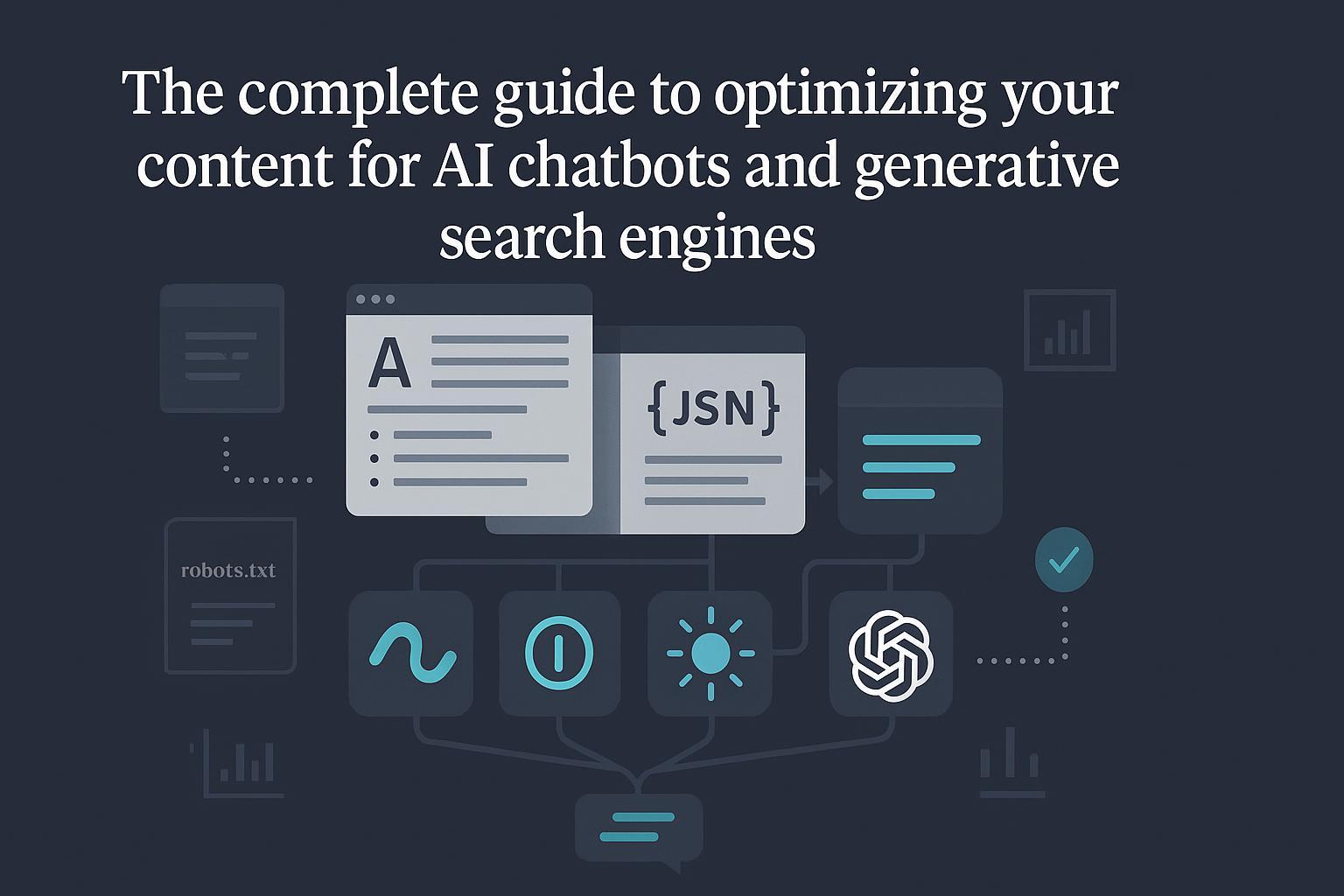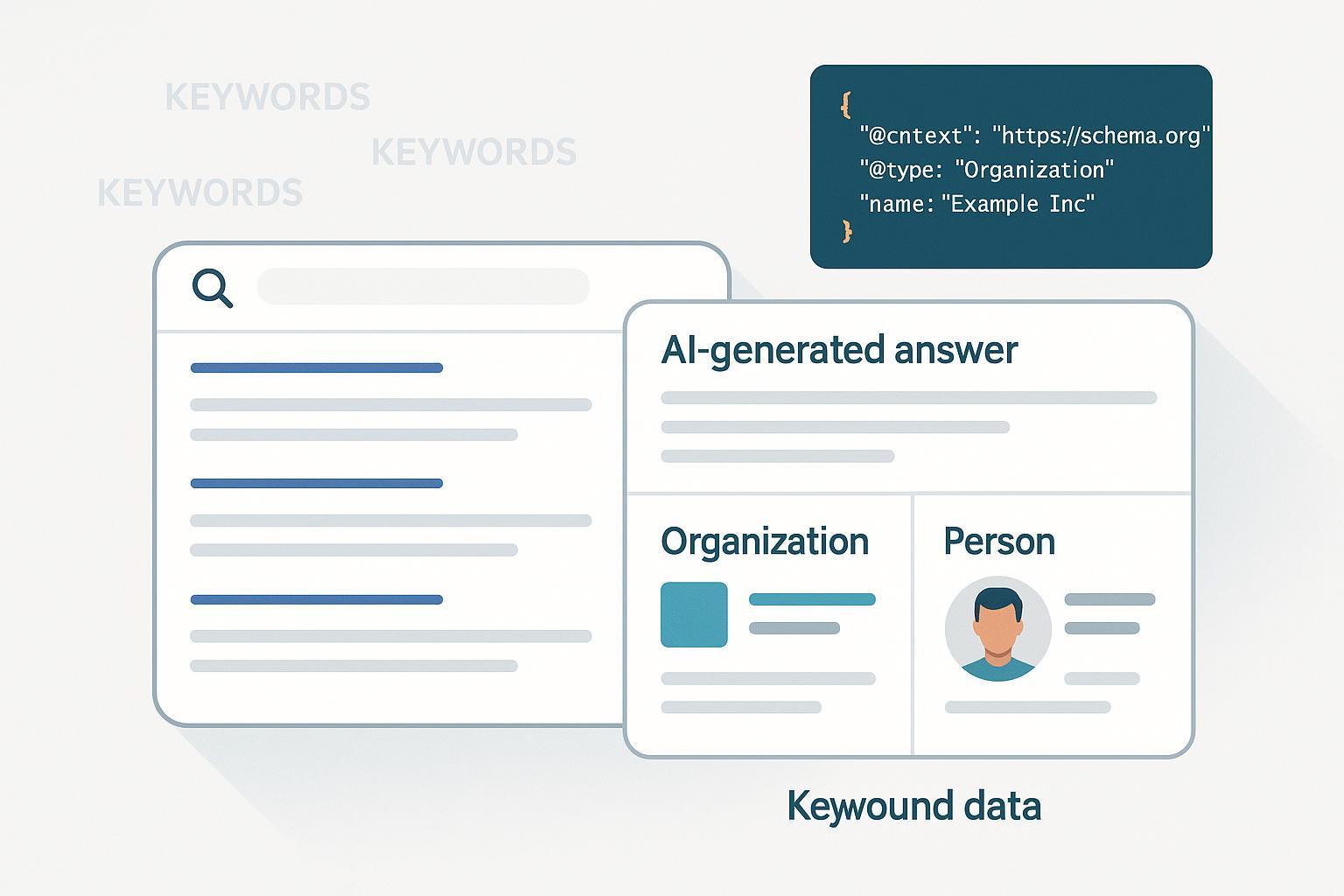Gartner’s 2025 Forecast: 25% Drop in Searches as AI Tools Rise
Gartner predicts a 25% drop in traditional searches by 2026. Learn what new data and expert advice mean for your strategy—act before it’s too late.


Traditional search isn’t disappearing, but the ground is shifting fast. Gartner forecast in early 2024 that by 2026, traditional search engine query volume could fall by about 25% as users turn to AI chatbots and virtual agents—a claim widely covered by industry outlets and attributed to Gartner analyst Alan Antin. See the phrasing echoed in Danny Goodwin’s coverage at Search Engine Land (2024) and Portada’s summary citing Antin in Feb 2024. While Gartner’s primary note is paywalled, the prediction has remained central through 2025 as AI experiences roll out across Google and Microsoft.
Why this matters now (Q4 2025)
With 2026 less than 15 months away, CMOs, Heads of SEO, and brand leaders are finalizing budgets and re-baselining KPIs. The risk isn’t that “SEO dies,” but that your reporting fails to capture where attention is moving. Google’s AI features have accelerated: the company detailed AI Mode and expanded AI Overviews in May–August 2025, emphasizing deeper reasoning, multimodality, and follow-ups, as seen in Google’s descriptions in AI Mode update (May 2025) and the broader AI Mode/agentic expansion in Aug 2025. Microsoft is pushing similar blended experiences through Copilot Search in Bing (Apr 2025).
What the evidence shows — usage vs. clicks
Two truths can coexist:
- Platform usage and satisfaction can rise when AI answers appear. Google stated in May 2025 that in major markets like the U.S. and India, AI Overviews drove “over 10% increase in usage of Google” for queries that show AI Overviews (Google Blog, 2025) in its AI Mode update.
- External clicks to publishers often fall when AI summaries show. Multiple independent datasets in 2024–2025 point to CTR declines on informational queries:
- Ahrefs (Apr 2025) observed among 300,000 keywords that the #1 result’s CTR dropped from ~7.3% to ~2.6% on AI Overview-triggered terms—a sizable reduction—reported in Ahrefs’ 2025 analysis.
- Pew Research (Jul 2025) found that users were less likely to click when AI summaries appeared—roughly 15% CTR without AIO vs ~8% with AIO in its short read on Google users (2025).
- Publisher cohorts have reported 1%–25% referral declines linked to AI Overviews, as summarized by Digiday in Aug 2025.
Taken together, this explains Gartner’s directional thesis: more answers stay on-platform, so some query intent shifts away from traditional SERPs. It’s also uneven by category: surveys like NP Digital’s mid-2025 study suggest some marketers see traffic increases despite AIO, underscoring the importance of segmented measurement.
Measure what matters: a dual-KPI model for 2025–2026
You can’t manage what you don’t measure. Recast your reporting into two complementary lenses:
-
Traditional SEO/SERP KPIs
- Impressions, ranking positions, organic CTR, qualified clicks/conversions
- Segmented by intent: informational vs transactional vs navigational
- Track AI Overview presence rate by query cluster using Search Console and third-party SERP tools
-
AI Answer Visibility & Sentiment KPIs
- Citation presence rate across engines (Google AI Overviews, Bing/Copilot Search, ChatGPT, Perplexity)
- Sentiment distribution in AI answers (positive/neutral/negative) about your brand and products
- “AI Search Visibility Score” combining citation frequency, placement, and sentiment trend; see the definition in What is AI Search Visibility Score?
To operationalize this, teams can adopt cross-engine monitoring platforms that aggregate AI-answer citations and sentiment. Geneo supports tracking brand mentions across Google AI Overviews, ChatGPT, Perplexity, and more, alongside historical query records and optimization recommendations. Disclosure: Geneo is our product.
Minimum weekly cadence (start simple, then automate):
- Audit 50–100 priority prompts per engine (Google, Bing/Copilot, ChatGPT, Perplexity)
- Record citation presence/absence, source quality, and sentiment
- Note week-over-week deltas and any model/feature changes
- Use a beginner-friendly workflow outlined in AI Search Visibility Optimization: Beginner’s Guide, and expand to brand-level reports like tracking visibility in AI answers.
Scenarios for 2026 planning: 10% / 25% / 40% shift
Treat Gartner’s 25% figure as the midpoint of a planning band. Build three scenarios to stress-test budgets and pipeline:
-
10% shift (conservative)
- Impact: Mild decline in non-branded informational clicks; transactional queries less affected.
- Response: Increase content refresh cadence on evergreen pages; prioritize citation-friendly summaries and structured data. Strengthen entity signals (authors, organization, product schemas).
-
25% shift (base case)
- Impact: Measurable drop in informational CTR and publisher referrals; paid search may see uneven efficiency as users engage with AI answers first.
- Response: Reallocate 10%–20% of SEO/SEM budget to AI-visibility initiatives—source seeding, entity optimization, and cross-engine monitoring. Elevate executive dashboards to include AI visibility and sentiment.
-
- Impact: Significant zero-click behavior; traditional reporting undercounts “influence” from AI answers. Organic traffic to upper-funnel content compresses.
- Response: Double down on original research, citation seeding, and partnerships that increase likelihood of appearing in AI summaries. Launch reputation management routines for AI narratives. Expand measurement coverage and alerts across engines.
Budget levers to model in each scenario:
- Content operations: refresh velocity; add concise “answer blocks”; maintain author bios and About pages
- Structured data: product, FAQ, HowTo schemas; entity enrichment via authoritative references
- Source seeding: publish method-transparent research; provide clear citations; engage credible third-party coverage
- Monitoring/QA: weekly AI-answer scans; sentiment remediation; source quality checks
The playbook: how to earn citations and protect brand narrative
-
Source seeding and original research
- Invest in method-transparent studies that AI engines can cite. Include sample sizes, dates, and clear references.
-
- Strengthen your presence in knowledge graphs with consistent naming, schema, and authoritative profiles. Align product and organization entities with well-referenced pages.
-
Content refresh and citation-friendly formats
- Add succinct summaries, FAQs, and clear attribution lines to evergreen guides. Maintain up-to-date references and external links to primary sources.
-
Reputation management in AI answers
- Monitor sentiment regularly; where negative or outdated narratives appear, publish clarifications and coordinate PR. Over time, authoritative, accurate content tends to surface in AI citations.
-
Technical hygiene
- Follow Google’s guidance on AI features and measurement (Search Console “Web” type counts AI features); adjust robots/meta directives if needed, per Google Developers’ documentation (June 2025).
What to watch next (updated monthly)
- Google AI Overviews rollout and CTR studies; keep an eye on new cohorts and measurement methods
- Bing/Copilot Search feature updates and citation behavior
- Adoption metrics for AI assistants (ChatGPT’s weekly user base continues to grow—Sam Altman referenced ~800M weekly users in Business Insider, Oct 2025)
- Official disclosures from Google/Microsoft on query mix or measurement guidance
- Third-party clickstream analyses that separate branded vs non-branded, informational vs transactional
Mini FAQ
-
Will SEO die?
- No. But upper-funnel discovery is changing. Expect blended journeys where AI answers handle summary/overview and traditional results capture deeper research and transactions.
-
How do I measure brand presence in AI answers?
- Track citation presence across engines, sentiment, and share of voice for priority prompts. Start with a weekly cadence and expand toward automation.
-
How do AI answers cite sources?
- Bing/Copilot typically provides “clearly cited sources,” while Google AI Overviews are more variable by query. Ensure your content is trustworthy, well-structured, and easy to attribute.
Closing and next steps
If your 2026 plan still treats AI answers as an afterthought, you’re flying blind. Stand up a dual-KPI reporting model, run the 10%/25%/40% budget scenarios, and begin weekly AI-answer monitoring across engines. To see how cross-engine visibility and sentiment tracking fits into your stack, consider exploring a demo of platforms like Geneo.
Updated on October 09, 2025: Added 2025 CTR studies from Ahrefs and Pew; noted Google’s AI Mode usage claim and Microsoft’s Copilot Search launch; expanded measurement guidance.




